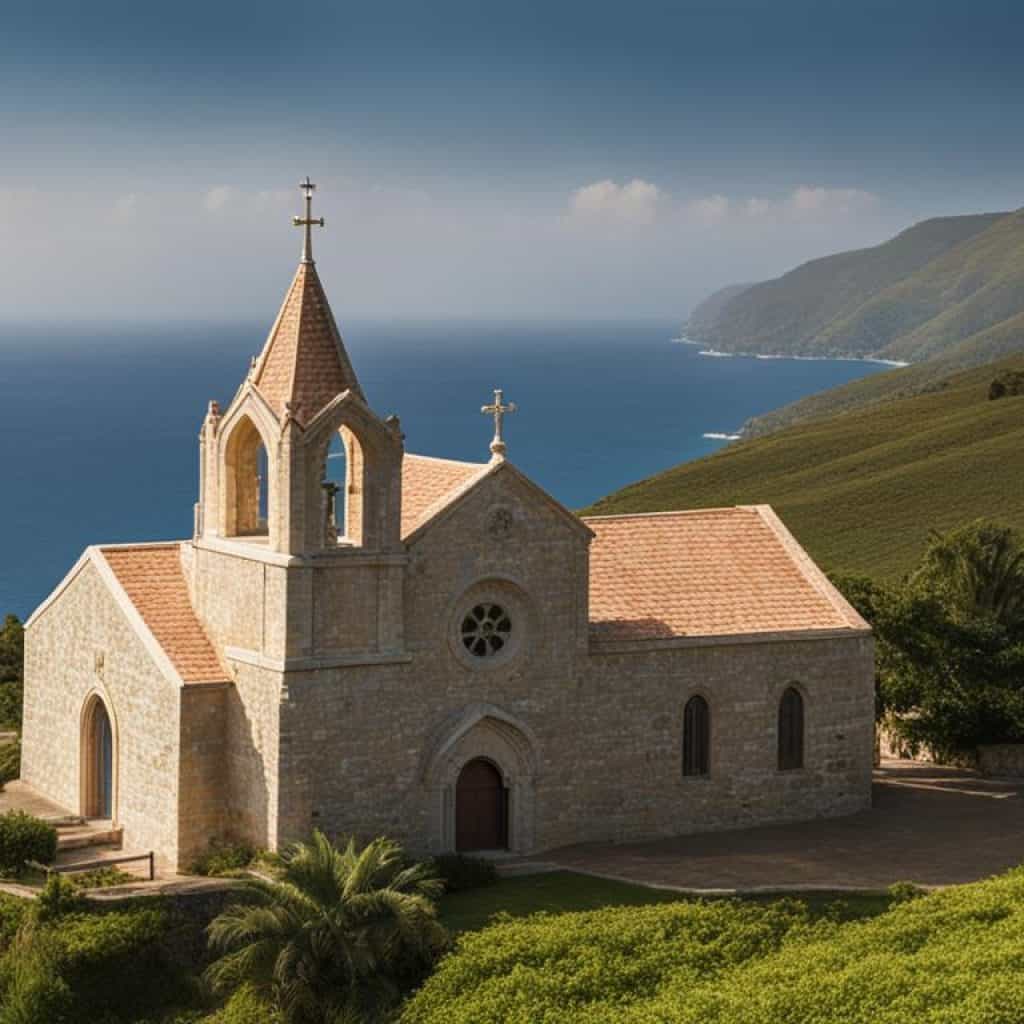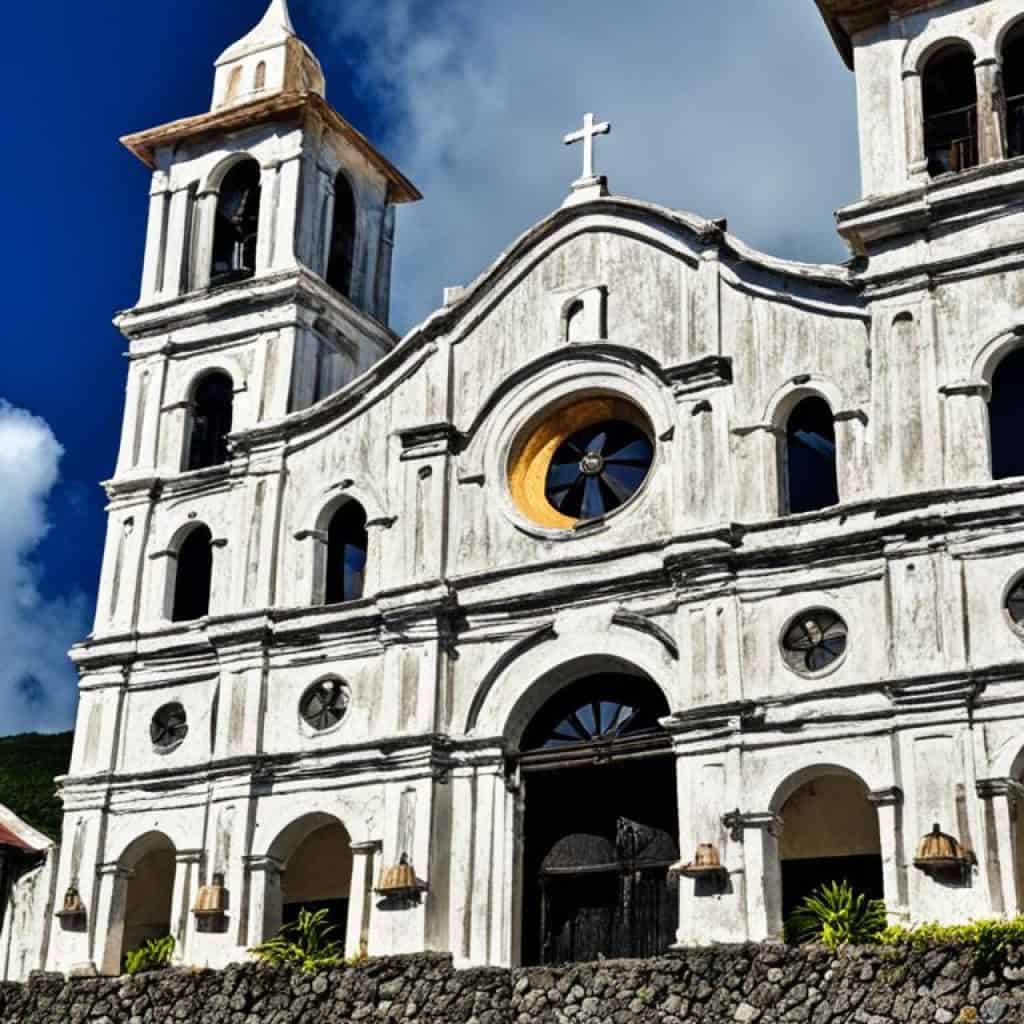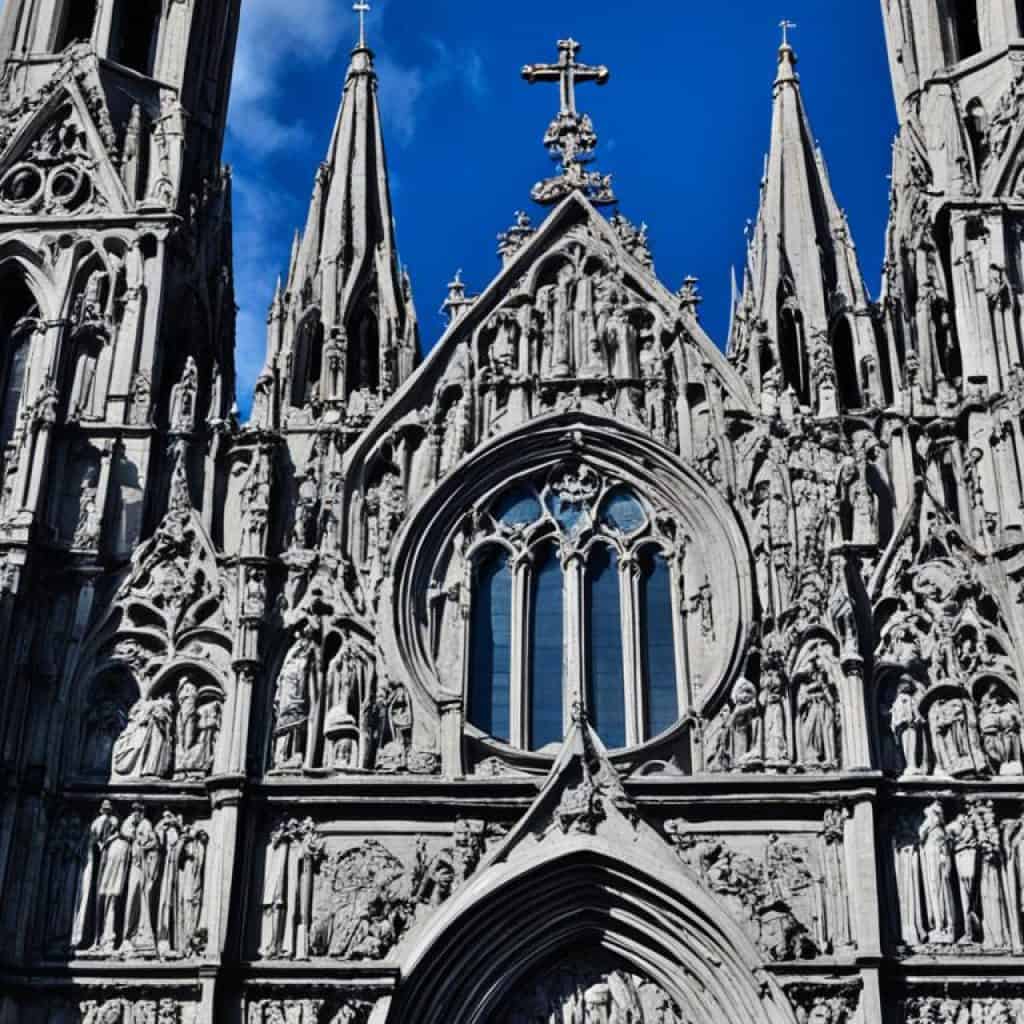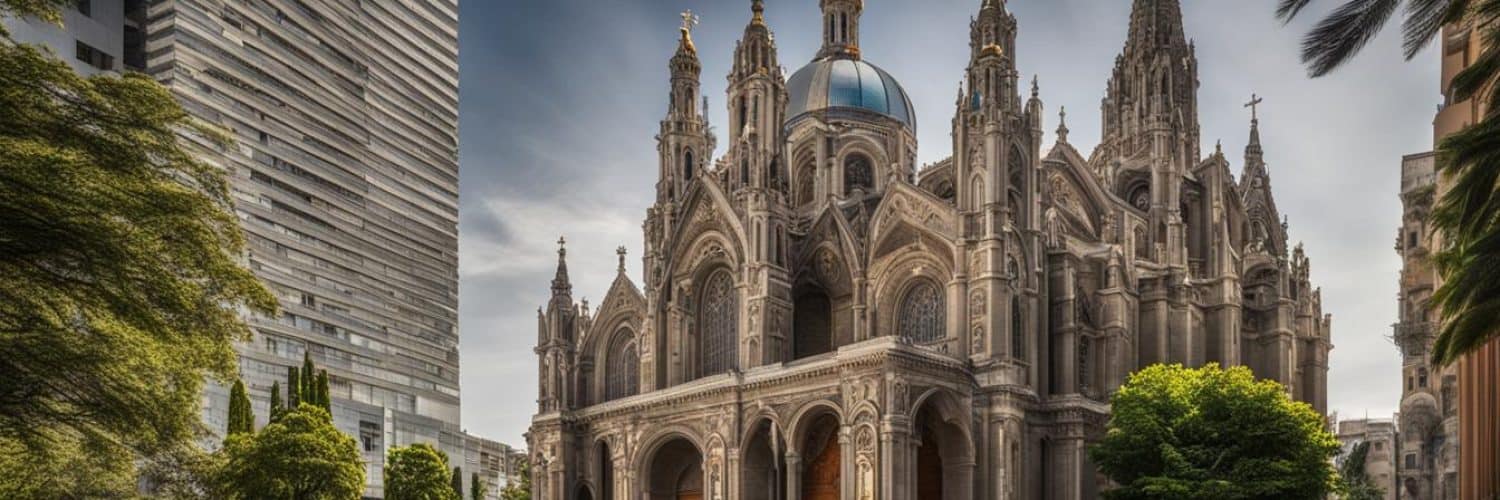Have you ever wondered which church holds the title for being the largest in the Philippines? Is it a majestic cathedral nestled in a bustling city or a hidden gem in a remote province? Join us on a journey as we uncover the secrets of the biggest cathedral in the Philippines, a famous religious site that has captivated the hearts of locals and tourists alike.
Key Takeaways:
- Discover the cultural and historical significance of the largest church in the Philippines.
- Learn about the foundation of Catholicism in the Philippines and its impact on Filipino identity.
- Uncover the tradition of Visita Iglesia and its role in Filipino Catholic culture.
- Explore other notable churches in different regions of the Philippines, each with its own unique charm and historical importance.
- Understand the role of these churches as top tourist attractions and landmarks in Southeast Asia.
The Foundation of Filipino Identity: Catholicism in the Philippines
Catholicism has played an integral role in shaping the cultural fabric of the Philippines since the Spanish colonial period. Over the course of 300 years, the introduction of Catholicism profoundly influenced the beliefs and values of the Filipino people. Today, the Philippines proudly claims one of the largest Catholic populations in Asia, with century-old churches standing as enduring testaments to the country’s rich history, having withstood wars and natural disasters.
During the Spanish colonial period, Catholicism became deeply ingrained in the everyday lives of Filipinos. Spanish missionaries, most notably the Augustinians, Franciscans, and Jesuits, established numerous churches, monasteries, and convents, imparting not only religious teachings but also education, art, and architecture. As a result, the influence of Catholicism permeates every facet of Filipino culture, from religious practices and holidays to social norms and family values.
The Catholic Church played a pivotal role in the colonization of the Philippines, serving as a tool for the Spanish colonizers to assert control and spread their influence. The Catholic faith was used as a means to assimilate the indigenous population, resulting in the emergence of Christianity as the predominant religion in the country. The Spanish authorities constructed magnificent churches, some of which still stand today, symbolizing the enduring presence of Catholicism in Philippine society.
“The Catholic faith holds a significant place in the hearts of Filipinos, as it has shaped their identity and provided solace during challenging times. The century-old churches scattered across the archipelago stand as tangible reminders of the Filipino people’s deep-rooted faith and resilience.”
The Filipino devotion to Catholicism has persisted through centuries of colonization, political upheaval, and natural disasters. These century-old churches, with their intricate architecture and rich historical significance, serve as centers of worship and pilgrimage, attracting both local devotees and tourists alike. They provide a glimpse into the country’s past, offering a spiritual connection to the generations of Filipinos who have found comfort and strength in their faith.
The Enduring Legacy of Catholicism in the Philippines
The Spanish colonial period and the introduction of Catholicism left an indelible mark on the Filipino identity. The country’s religious landscape is a reflection of this legacy, with Catholicism deeply embedded in its social, cultural, and political spheres. The Filipino people’s unwavering faith, exemplified by their steadfast commitment to Catholic traditions and the preservation of century-old churches, serves as a testament to the enduring legacy of Catholicism in the Philippines.
These century-old churches stand as symbols of resilience, surviving countless challenges throughout Philippine history. From earthquakes to wars, these architectural marvels have withstood the test of time, carrying the stories of generations past. They not only serve as places of worship but also as cultural landmarks and tourist attractions, offering a glimpse into the country’s rich religious and historical heritage.
The Tradition of Visita Iglesia: A Pilgrimage of Faith
The tradition of Visita Iglesia, or church visitation, holds a special place in Filipino Catholic culture. It is a beautiful practice that involves visiting multiple churches in a day, typically during the Holy Week in March or April. This pilgrimage allows individuals to reflect on the Stations of the Cross at each site and deepen their faith.
During the Holy Week, many Filipinos embark on Visita Iglesia as a way to honor and commemorate the passion, death, and resurrection of Jesus Christ. It is a time of spiritual renewal and devotion, making it one of the most significant religious pilgrimages in the Philippines.
“In the footsteps of Jesus, we find solace, inspiration, and strength. Visita Iglesia offers us a unique opportunity to meditate on His sacrifice and immerse ourselves in His love.” – Anonymous
Throughout the pilgrimage tour, participants visit several churches, often choosing those that hold historical or cultural significance. The number of churches visited varies from person to person, with some completing as many as 14 churches, representing the Stations of the Cross. Each church holds a solemn atmosphere, allowing pilgrims to reflect on the suffering, death, and resurrection of Jesus.
This tradition is not limited to locals; tourists from different parts of the world also take part in Visita Iglesia to witness the rich religious heritage of the Philippines. The pilgrimage tours provide a unique opportunity to explore the country’s architectural treasures and experience the profound faith that Filipinos hold dear.
Benefits of Visita Iglesia
Participating in Visita Iglesia offers various benefits to pilgrims. It allows for:
- Deepening of faith and spiritual growth
- Reflection and contemplation on the Stations of the Cross
- Experiencing the rich Catholic heritage of the Philippines
- Exploration of historical and culturally significant churches
- Connection with fellow pilgrims and the local community
The sense of camaraderie and spiritual connection experienced during Visita Iglesia is truly remarkable. It creates a shared bond among participants, leading to a stronger sense of community and a deepened understanding of the Catholic faith.
Mt. Carmel Chapel (Batanes): A Quintessential Stone Church
In the idyllic province of Batanes, nestled amidst the breathtaking landscapes, stands the remarkable Mt. Carmel Chapel, also known as Tukon Church. This picturesque stone church captivates visitors with its timeless beauty and unique architectural design inspired by traditional stone houses.
Perched on top of a hill, Mt. Carmel Chapel offers an enchanting view of the natural wonders that surround Batanes. From its vantage point, one can marvel at the panoramic vistas of the Pacific Ocean, the West Philippine Sea, and the verdant landscapes that define this pristine island province.
While the Mt. Carmel Chapel serves as a place of worship for locals, it has also become a sought-after venue for private, intimate wedding celebrations. The serene ambiance and stunning backdrop make it an ideal setting for couples seeking to exchange vows in a place of tranquil beauty.
Whether you’re visiting Batanes for its awe-inspiring landscapes or attending a private wedding celebration, a visit to Mt. Carmel Chapel, the quintessential stone church, is an experience that will leave an indelible mark on your heart.

Key Features of Mt. Carmel Chapel (Batanes)
| Location | Architecture | Views | Events |
|---|---|---|---|
| Batanes | Stone church inspired by traditional houses | Breathtaking views of the Pacific Ocean, the West Philippine Sea, and Batanes landscapes | Private wedding celebrations |
Binondo Church (Manila): The Oldest Chinatown’s Landmark
Binondo Church, also known as the Minor Basilica and National Shrine of Saint Lorenzo Ruiz, is a historic church located in Binondo, Manila, the oldest Chinatown in the world.
Established in 1596 by Dominican priests, Binondo Church played a significant role in the conversion of Chinese immigrants to Christianity. The church holds historical significance as a testament to the early presence of Chinese converts in the Philippines.
Despite being heavily damaged during World War II, Binondo Church has been meticulously restored to its former glory. Today, it continues to hold regular masses in various languages, attracting both locals and tourists who seek spiritual solace and appreciate the church’s architectural beauty.
Historical Significance
Binondo Church stands as a symbol of the cultural fusion between the Philippines and China. Its establishment and subsequent preservation signify the harmonious coexistence and integration of different cultures within the country.
“Binondo Church serves as a bridge between different communities and reminds us of our shared history and faith.” – Local Resident
The church also serves as a vital link to the flourishing Chinese-Filipino community, showcasing its contributions to the country’s growth and development.
Architectural Highlights
Binondo Church’s architectural design reflects the blending of Filipino and Chinese influences. Its facade boasts intricate details and carvings, showcasing the craftsmanship of the artisans who worked on its construction.
Inside the church, visitors can admire the beautiful stained glass windows and the ornate altar adorned with religious icons. It exudes a sense of serenity and reverence, providing a peaceful sanctuary for worshipers and visitors alike.
Visit Binondo Church
A visit to Binondo Church offers a glimpse into the historical and cultural tapestry of the Philippines. Whether you’re a devout Catholic, a history enthusiast, or a traveler seeking unique experiences, this iconic landmark is a must-visit destination in Manila.
| Church Name | Location | Year Established |
|---|---|---|
| Binondo Church | Binondo, Manila | 1596 |
Join the countless individuals who have marveled at Binondo Church’s historical significance, architectural grandeur, and cultural importance. Experience a harmonious blend of spirituality and cultural heritage as you step foot into this iconic landmark in the heart of Manila.
Caleruega Church (Batangas): Where Nature Meets Spirituality
Nestled in the scenic province of Batangas, Caleruega Church, also known as the Transfiguration Chapel, offers a serene retreat place where nature meets spirituality. This hilltop sanctuary provides a peaceful escape from the bustling city life, surrounded by breathtaking views of lush hills, verdant farmland, and the majestic Batulao Mountains.
Established in 1995, Caleruega Church holds a special place in the hearts of both locals and tourists seeking solace, reflection, and prayer. Its tranquil setting and beautiful surroundings make it an ideal location for retreats, spiritual gatherings, and even wedding celebrations.
The church was aptly named after the birthplace of St. Dominic de Guzman, the founder of the Order of Preachers, creating a connection between the spiritual heritage of Caleruega and its natural environment. Visitors can explore the church’s serene gardens, tranquil pathways, and serene meditation spots, allowing them to connect with both nature and their inner spirituality.
What sets Caleruega Church apart is its proximity to the picturesque city of Tagaytay. Located only a short distance away, Tagaytay offers stunning views of the Taal Volcano and Taal Lake, creating an even more immersive retreat experience for visitors.
“Caleruega Church provides a sanctuary where one can escape the noise of everyday life and find solace in the beauty of nature and the power of spirituality. Its idyllic location and peaceful surroundings make it a perfect retreat place for individuals seeking contemplation and renewal.”
Caleruega Church: A Haven for Weddings
Aside from its spiritual significance, Caleruega Church is also a popular wedding church. Its breathtaking backdrop of rolling hills and stunning landscapes creates a romantic ambiance that is perfect for couples exchanging their vows.
The church’s intimate atmosphere, surrounded by nature’s beauty, sets the stage for a truly unforgettable wedding experience. Whether it’s a small gathering or a grand celebration, Caleruega Church provides a stunning venue that enhances the emotions and memories of the special day.
Wedding ceremonies held at Caleruega Church also offer the opportunity for couples and their guests to explore the surrounding area, enjoying the natural beauty of Batangas and the nearby attractions of Tagaytay.
Caleruega Church – At a Glance
The table below provides an overview of Caleruega Church, showcasing its key features and amenities:
| Features | Description |
|---|---|
| Location | Batangas |
| Alternate Name | Transfiguration Chapel |
| Established | 1995 |
| Surroundings | Hills, Farmland, Batulao Mountains |
| Proximity to Tagaytay | Nearby |
| Special Events | Retreats, Spiritual Gatherings, Weddings |
Caleruega Church provides a unique blend of spirituality and natural beauty, offering a serene retreat place where visitors can find solace, reflection, and a deeper connection with themselves and the environment. Its idyllic location and picturesque surroundings make it a sought-after destination for those seeking a tranquil escape in the heart of Batangas.
Baclayon Church (Bohol): A Testament to Resilience
Baclayon Church, located in Bohol, is one of the oldest Catholic churches in the Philippines, dating back to 1727. This significant historical landmark has withstood the test of time, surviving earthquakes and fires, making it a true testament to resilience.
Founded by Jesuit missionaries, Baclayon Church holds immense cultural value. It has been declared as a National Cultural Treasure and a National Historic Landmark, recognized for its architectural and historical significance.
Visitors to Baclayon Church have the opportunity to admire a collection of historical artifacts housed within the church. These artifacts include religious antiques dating back to the 16th century, offering a glimpse into the rich history of the Philippines and the influence of Spanish conquistadors on the region.
The preservation of Baclayon Church is a testament to the unwavering faith and determination of the Filipino people. Despite facing natural disasters and the challenges of time, this iconic church stands as a symbol of the country’s enduring spiritual heritage and cultural identity.

The Historical Significance of Baclayon Church
Baclayon Church, founded by Jesuit priests in 1727, showcases the rich influence of Spanish conquistadors on the Philippines. This historical landmark has survived the test of time, standing as a poignant reminder of the deep-rooted Catholic faith that shaped the nation.
Preserving Cultural Treasures
- Baclayon Church is a declared National Cultural Treasure and National Historic Landmark, emphasizing its cultural and historical significance.
- The church houses a collection of historical artifacts, including religious antiques dating back to the 16th century.
- Preservation efforts ensure that future generations can appreciate the rich historical and spiritual heritage embodied by Baclayon Church.
A Symbol of Resilience
Despite enduring natural disasters and the test of time, Baclayon Church stands steadfast, radiating a sense of resilience and inspiring visitors with its unwavering faith.
| Year Founded | Architectural Style | Declared Status |
|---|---|---|
| 1727 | Baroque | National Cultural Treasure & National Historic Landmark |
Barasoain Church (Bulacan): Witness to Philippine History
Barasoain Church, also known as Our Lady of Mount Carmel Parish, holds great historical significance in the Philippines. Located in Malolos, the capital of Bulacan province, it was the venue for three important events in Philippine history: the First Philippine Congress, the drafting of the Malolos Constitution, and the inauguration of the First Philippine Republic.
The church stands as a symbol of the country’s struggle for independence and serves as a reminder of the resilience and determination of the Filipino people. Its architectural beauty and historical importance make it a top destination for both pilgrims and history enthusiasts.
Explore the Barasoain Museum adjacent to the church, where you can delve deeper into the rich history of the Philippines through exhibits, artifacts, and interactive displays. The museum provides a comprehensive narrative of the country’s journey towards nationhood.
Historical Events Associated with Barasoain Church:
- The First Philippine Congress: Held in Barasoain Church in 1898, the congress marked the establishment of a representative government in the Philippines.
- The drafting of the Malolos Constitution: Barasoain Church was the venue for the drafting of the country’s first constitution in 1898, laying the foundation for the Philippines as an independent nation.
- The inauguration of the First Philippine Republic: On January 23, 1899, the church witnessed the historic inauguration of the First Philippine Republic and the swearing-in of Emilio Aguinaldo as the country’s first president.
“Barasoain Church stands as a testament to the courage and determination of the Filipino people in their pursuit of freedom and self-governance.” – Dr. Jose Rizal
Barasoain Museum: Unraveling Philippine History
The Barasoain Museum, just a stone’s throw away from the church, offers a captivating journey through Philippine history. Immerse yourself in the interactive exhibits and galleries that showcase the country’s struggle against colonial rule and the formation of its identity as a nation.
| Highlights of Barasoain Museum | Description |
|---|---|
| The Freedom Trail | A guided tour that takes you through the significant milestones in the quest for Philippine independence. |
| The Malolos Republic Gallery | Discover the history and significance of the Malolos Republic, the first republic in Asia. |
| The Revolution and Propaganda Gallery | Explore the events that led to the Philippine Revolution and the influential propaganda movement. |
| The Martyrdom Gallery | Pay homage to the heroes of the Philippine Revolution and learn about their sacrifices. |
Visit Barasoain Church and immerse yourself in the rich history and culture that encapsulates the Filipino spirit. Stand in the halls where important decisions were made and experience the profound sense of national identity that continues to pulse through the hearts of the Filipino people.
Santa Maria Church (Ilocos Sur): A Majestic Baroque Beauty
Santa Maria Church, situated in Ilocos Sur, is a stunning example of Baroque architecture and is recognized as a UNESCO World Heritage Site. Built in 1769, this church stands proudly atop a hill, showcasing a unique brick-and-mortar design that captivates visitors with its elegance.
As you ascend the flight of stairs leading to the church, prepare to be awestruck by the scenic views that unfold before your eyes. The lush greenery surrounding the church creates a peaceful and serene atmosphere, offering a tranquil retreat from the bustling world below.
Stepping inside the church, you’ll be greeted by the grandeur of the Baroque architecture, characterized by ornate details, intricate carvings, and vibrant frescoes. The interior exudes a sense of wonder and reverence, inviting visitors to pause and reflect in its sacred space.
A Symbol of Faith and History
The Santa Maria Church is more than just a place of worship; it’s a testament to the enduring faith and rich history of the Filipinos.
Throughout its existence, the Santa Maria Church has witnessed significant events and stood as a beacon of hope for the community. Its timeless beauty serves as a reminder of the legacy and resilience of the people of Ilocos Sur.
Visiting Santa Maria Church is not only a chance to admire its architectural splendor but also an opportunity to immerse yourself in the cultural heritage of the Philippines. The quiet elegance, scenic surroundings, and historical significance make this church a must-visit destination for travelers seeking a deeper understanding of the country’s past and present.
Preserving a Heritage
The UNESCO World Heritage Site designation bestowed upon Santa Maria Church recognizes its outstanding universal value and the need to protect and preserve its architectural and cultural significance for future generations.
By visiting Santa Maria Church, you contribute to the preservation efforts and help ensure that this magnificent Baroque beauty continues to inspire and captivate visitors for years to come.
Discover the allure of Santa Maria Church, where artistry, history, and spirituality intertwine to create an unforgettable experience. Plan your visit to this majestic Baroque landmark and be prepared to be enraptured by its charm and grace.
Molo Church (Iloilo): A Feminist Church of Gothic-Renaissance Design
The Molo Church, also known as St. Anne Parish Church, is a remarkable example of a Gothic-Renaissance church located in Iloilo, outside of Manila. This architectural masterpiece is renowned for its unique feature: 16 statues of female saints, elegantly arranged in two rows inside the church. As a feminist church, it stands as a symbol of empowerment and celebrates the significant role of women in the Catholic faith.
The Molo Church showcases a harmonious blend of Gothic and Renaissance architectural elements, captivating visitors with its intricate details and grandeur. Its towering spires, adorned with delicate carvings, reach towards the heavens, inspiring a sense of awe and reverence. The church’s stunning stained glass windows allow warm, colorful rays of light to filter through, creating an ethereal ambiance.
“The Molo Church is a testament to the strength and resilience of women in the religious realm. It beautifully combines the Gothic and Renaissance styles, highlighting the importance of inclusivity and empowering women in the Catholic tradition.” – Architectural Digest
Stepping inside the Molo Church, visitors are greeted by a tranquil atmosphere and an overwhelming sense of peace. The intricate altar, adorned with ornate decorations, serves as the focal point of the church. It is here that faithful individuals come to pray, seeking solace and guidance.
This feminist church has become a popular attraction for those interested in historical and architectural wonders. Visitors can immerse themselves in the rich history and cultural significance of the Molo Church, marveling at the delicate craftsmanship and attention to detail. The church’s unique feminist perspective sets it apart from other churches in the Philippines, making it a must-visit destination for travelers.
Experience the awe-inspiring beauty of the Molo Church and witness the profound impact of women in the Catholic faith. This remarkable Gothic-Renaissance masterpiece serves as a testament to the enduring spirit of inclusivity and empowerment.

Key Features of Molo Church:
| Gothic-Renaissance Architecture | A harmonious blend of Gothic and Renaissance styles, inspiring awe and admiration. |
|---|---|
| Feminist Church | 16 statues of female saints arranged in two rows, celebrating the important role of women in the Catholic tradition. |
| Ornate Altar | An intricately designed altar, adorned with ornate decorations, serving as the focal point of the church. |
| Visitors’ Experience | A tranquil and peaceful atmosphere, allowing visitors to immerse themselves in history and culture. |
Daraga Church (Albay): A Historic Church With a View
Daraga Church, also known as Our Lady of the Gate Parish Church, is a historical church located in Albay. Situated on top of a hill overlooking the majestic Mayon Volcano, this church offers visitors a breathtaking view of the iconic volcano and its picturesque surroundings.
Built in 1773, Daraga Church stands as a testament to the area’s rich history and religious heritage. Its Baroque-style architecture and intricate details showcase the craftsmanship of the past. The church’s facade features detailed carvings, ornate columns, and a bell tower that adds to its grandeur.
Aside from its historical significance and architectural beauty, Daraga Church is also a popular lookout point for nature enthusiasts. The panoramic view of Mayon Volcano from the church grounds is truly awe-inspiring and offers a unique perspective of this natural wonder.
Visitors have the opportunity to connect with both history and nature in one place. The presence of the church atop the hill, juxtaposed with the scenic backdrop of Mayon Volcano, creates a serene and enchanting atmosphere.
Whether you are a religious pilgrim seeking spiritual solace or a nature lover in search of breathtaking views, Daraga Church is a must-visit destination in Albay, Philippines. Come and immerse yourself in the rich culture, history, and natural beauty that this historic church and its surroundings have to offer.
San Sebastian Church (Manila): A Gothic Revival Marvel
The San Sebastian Church, also known as San Sebastian Basilica, is an architectural masterpiece that showcases the beauty of Gothic Revival architecture. Situated in Manila, this church is a true marvel that captivates visitors from around the world.
What sets San Sebastian Church apart is its unique distinction as the only steel building church in the Philippines. Designed by the renowned architect Genaro Palacios, the church’s steel structure is adorned with intricate details and magnificent stained glass windows, creating a visually stunning and ethereal atmosphere.
Recognized for its architectural significance, San Sebastian Church has been declared a National Historical Landmark and a National Cultural Treasure, further highlighting its cultural and historical importance.
Visiting San Sebastian Church is more than just an architectural experience; it is a journey through time and faith. As you step inside, you can’t help but feel a sense of awe as the grandeur of the church envelops you. The intricate details, from the soaring ceilings to the delicate stained glass, create a serene and majestic atmosphere that leaves a lasting impression.
In addition to its architectural splendor, San Sebastian Church holds a significant place in the hearts of the Filipino people. It serves as a place of worship and a beacon of faith, bringing people together to celebrate their beliefs and find solace in their spirituality.
As you explore this Gothic Revival marvel, take a moment to appreciate the remarkable feat of engineering that allows the church to stand tall amidst the bustling city of Manila. Its steel structure not only showcases the ingenuity of its architect but also represents the resilience and strength of the Filipino people.
“San Sebastian Church is a testament to the rich history and cultural heritage of the Philippines. Its Gothic Revival architecture and steel structure make it a singular landmark in the country. Visiting this remarkable church is a must for anyone who appreciates art, history, and spirituality.”
Key Features of San Sebastian Church:
- Unique distinction as the only steel building church in the Philippines
- Gothic Revival architecture with intricate details and stained glass windows
- Declared a National Historical Landmark and a National Cultural Treasure
- An architectural marvel that showcases the ingenuity of its architect, Genaro Palacios
- A place of worship and spiritual solace for the Filipino people
San Sebastian Church is not just an architectural gem but a symbol of the Philippines’ rich cultural heritage and enduring faith. It continues to attract visitors from near and far, inviting them to witness its grandeur and experience the reverence and awe that emanates from within its sacred walls.
| San Sebastian Church (Manila) | Location | Architectural Style |
|---|---|---|
| San Sebastian Church | Manila, Philippines | Gothic Revival |
Conclusion
The largest church in the Philippines, with its awe-inspiring architecture and rich history, stands as a symbol of faith and an iconic landmark in Southeast Asia. This magnificent religious site not only holds deep cultural importance but also attracts countless visitors, making it a top tourist attraction in the Philippines.
Visitors to the largest church in the Philippines are captivated by its grandeur and beauty. The intricate details and stunning designs of the church’s architecture showcase the rich craftsmanship of the Filipino people. As they step inside, they are surrounded by a sense of tranquility and spirituality, further enhancing their experience.
The significance of the largest church in the Philippines extends beyond its religious and architectural value. It serves as a testament to the enduring faith and the vibrant history of the Filipino people. This popular landmark holds a special place in the hearts of locals and tourists alike, providing a glimpse into the cultural tapestry of this diverse nation.


















Add comment